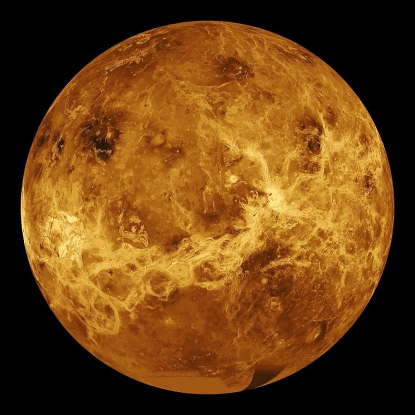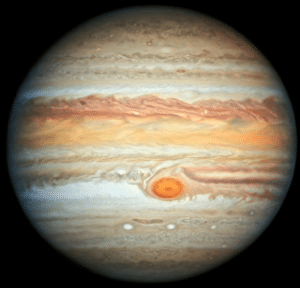Planets
Grade 5 Science Worksheets
A planet is an astronomical body moving in an elliptical orbit around a star. Planets are massive and are rounded and spherical in the structure under the influence of their own gravitational force. There are about 8 planets in our solar system.
These planets are divided into two types:
- Terrestrials: Planets like Mercury, Venus, Earth and Mars are terrestrials and are closer to the sun. They are primarily composed of rock and metal.
- Giant planets: They are massive planets and include Jupiter, Saturn, Uranus and Neptune. They are further divided into-
- Gas giants – They are composed mainly of hydrogen and helium and are the most massive of the planets. Jupiter and Saturn are gas giants.
- Ice giants – They are composed of substances with high melting points like water, ammonia and methane. Due to their rocky icy cores, they are called ice giants. They include Uranus and Neptune.
Schedule a Free session to clear worksheet doubts
No credit card required, no obligation to purchase.
Just schedule a FREE Sessions to meet a tutor and get help on any topic you want!
Planets in the solar system revolve around the SUN in their orbits under the influence of the sun’s gravitational pull. The time taken to complete one orbit around the sun is called their Orbital Period. Every planet rotates on its own axis counter-clockwise when viewed from the top, except Venus and Uranus that rotate in a clockwise direction. Let us study a bit more about each planet.


Mercury
Mercury is the smallest and innermost planet in the solar system. It has a rocky body, full of wrinkles and craters. It lies closest to the sun and its surface temperature is around 800 degrees Fahrenheit and is too hot to support human life. Its orbital period is 88 days, which means that a year in Mercury is just about 88 earth days long! The atmosphere of mercury has hydrogen, helium, sodium, oxygen, water vapor, and other gases.
Venus
Venus is the second planet from the sun and also the second-brightest natural object in the night sky. It is often referred to as earth’s sister planet because both Venus and Earth are similar in size, mass, density and volume. The atmosphere of Venus is highly dense with about 96.5% carbon dioxide that traps heat, causing a strong greenhouse effect. Due to this reason, Venus is the hottest planet in the solar system. The mean surface temperature of Venus is 864 degrees Fahrenheit and hence, cannot support human life.

Learn more about Planets and other important topics with 5th Grade Science Tutoring at eTutorWorld. Our expert science tutors break down the topics through interactive one-to-one sessions. We also offer the advantage of customized lesson plans, flexible schedules and convenience of learning from home.
eTutorWorld Understands Math Tutoring | Online Math Worksheets are Important Tools
Understanding graphs, charts, and opinion polls in a newspaper, for calculating house and car payments, and for choosing a long-distance telephone service are impossible without strong math skills …and the only way to develop strong math skills is by constant practice.
‘Practice makes a man perfect’ holds true for no other field better than for math. A middle or high school student must set aside a minimum of an hour for math every day. Other than textbooks, worksheets help you revise and understand concepts better.
Our expert tutors prepare online maths worksheets that are age and grade-appropriate. Grade-wise math worksheets for Elementary Math, Arithmetic, Pre-Algebra, Algebra, Geometry, Trigonometry, Statistics, Pre-Calculus and Calculus can be solved to improve math skills, to get ahead or to even catch up.
You may download these FREE online math worksheets in the PDF format, and then print and email us their solutions for a free evaluation and analysis by eTutorworld’smath expert tutors.
You may solve these worksheets by yourself or with your peers while studying together.
The Answer Key at the end of each worksheet allows for a self-evaluation.
Personalized Online Tutoring
eTutorWorld offers affordable one-on-one live tutoring over the web for Grades K-12, Test Prep help for Standardized tests like SCAT, CogAT, MAP, SSAT, SAT, ACT, ISEE and AP. You may schedule online tutoring lessons at your personal scheduled times, all with a Money-Back Guarantee. The first one-on-one online tutoring lesson is always FREE, no purchase obligation, no credit card required.
For answers/solutions to any question or to learn concepts, take a FREE CLASS.
No credit card required, no obligation to purchase.
Just book a free class to meet a tutor and get help on any topic you want!

Earth
Earth is the third planet from the sun and the fifth largest in the solar system. The atmosphere of the earth has layers of gases that are conducive to life. It contains 78% nitrogen, 21% oxygen, Argon (0.93%), carbon dioxide (0.04%), and other constituents like neon, helium, hydrogen, methane, water vapor, etc. About 29% of the Earth’s surface is land consisting of continents and islands and the remaining 71% is covered with water (hydrosphere). The earth’s core is rich in molten nickel-iron that generates an extensive magnetic field around it. The mean surface temperature of the earth is approximately 57 degrees Fahrenheit and hence, ideal to support the human life system. The earth’s atmosphere also protects us from the impact of meteors and comets.
Moon is the earth’s natural satellite. The moon’s gravitational force influences ocean tides and lengthening of days on earth.
Mars
Also known as the red planet, Mars can be easily seen from the earth with naked eyes. It is the second smallest planet in the Solar System. It has a solid surface with huge craters and it appears red due to the presence of iron oxide or rust. Mars’ atmosphere is mostly carbon dioxide with traces of nitrogen and argon. A Martian day is 40 minutes longer than a day on planet Earth. There in extensive ongoing research to check for availability of water and life on Mars. NASA has also started a long term program called Mars Exploration Program (MEP).

Closer view of Planet Mars

Jupiter
Jupiter is the largest planet in the solar system. It is one of the brightest objects visible in the night sky after Moon and Venus. Jupiter has a faint ring system which is invisible from earth. It has a dynamic weather system due to its quick rotations on its axis. It is the fastest spinning planet in the Solar System. It has a strong magnetic field that is 14 times stronger than Earth.
Saturn
A gas giant, it is the second largest planet in the solar system. It is the least dense planet and its atmosphere is extremely windy and light. Saturn’s most prominent feature is the ring around it, which mostly consists of ice particles, rock debris and dust. The cloud temperature is about -300 degrees Fahrenheit.
Schedule a Free session to clear worksheet doubts
No credit card required, no obligation to purchase.
Just schedule a FREE Sessions to meet a tutor and get help on any topic you want!


Closer view
Uranus
It is the third-largest planet in the solar system. The atmosphere of Uranus appears blue-green in color due to the presence of methane as it reflects shades of the color blue. The interior of Uranus is mainly composed of ice and rock. It has the coldest planetary atmosphere with a minimum of -371 degrees Fahrenheit.


Neptune
It is the farthest known planet from the sun. Neptune has huge storms, high wind speed, and temperatures go as low as -353 degrees Fahrenheit. It also appears blue, slightly brighter than Uranus, due to the presence of methane.
The table below gives some properties of the planets:

Check Point
Fill in the blanks:
- There are about__________ planets in our solar system.
- _________ and __________ are examples of terrestrial planets.
- __________ is the smallest and innermost planet of our solar system.
- The surface of Mars contains huge __________.
- __________ is the fifth planet from the sun.
- _________is the only natural satellite of Earth.
- The atmosphere of ice giant Uranus appears _________ in colour.
- The planet _________ takes the maximum time to complete its revolution around the sun.
Answer Key
- Eight
- Mercury, Venus, Earth, Mars (any two)
- Mercury
- Craters
- Jupiter
- Moon
- Blue green
- Neptune
Schedule a Free session to clear worksheet doubts
No credit card required, no obligation to purchase.
Just schedule a FREE Sessions to meet a tutor and get help on any topic you want!
Pricing for Online Tutoring
| Tutoring Package | Validity | Grade (1-12), College |
|---|---|---|
| 5 sessions | 1 Month | $139 |
| 1 session | 1 Month | $28 |
| 10 sessions | 3 months | $269 |
| 15 sessions | 3 months | $399 |
| 20 sessions | 4 months | $499 |
| 50 sessions | 6 months | $1189 |
| 100 sessions | 12 months | $2249 |
5th Grade Free Worksheets
- Galaxies
- The Solar System
- Planets
- Structure of Earth
- Plate Tectonics
- Earthquakes
- Volcano and Folded Mountains
- Mountains and Oceans
- Rocks and Fossils
- The Water Cycle
- What Causes Weather Patterns?
- Types of Precipitation
- Climate
- Difference between Weather and Climate
- Impact of Environmental Changes on Humans and Other Organisms
- Plants also Adapt
- Body Systems
- Skeletal System
- Human Nervous System
- Circulatory System
- Respiratory System
- Reproductive System
- Digestive System
- Excretory System
- Atomic Theory
- States of Matter
- Mixtures
- Chemical and Physical Changes
- Types of Energy
- Energy Transformations
- What is Electricity?
- Properties of Electricity
- Uses of Electricity
- Electrical Circuits
- What is Force?
- Newton’s Laws of Motion
IN THE NEWS

Our mission is to provide high quality online tutoring services, using state of the art Internet technology, to school students worldwide.
Online test prep and practice
SCAT
SSAT
ISEE
PSAT
SAT
ACT
AP Exam
Science Tutoring
Physics Tutoring
Chemistry Tutoring
Biology Tutoring
Math Tutoring
Pre-Algebra Tutoring
Algebra Tutoring
Pre Calculus Tutoring
Calculus Tutoring
Geometry Tutoring
Trigonometry Tutoring
Statistics Tutoring
Quick links
Free Worksheets
Fact sheet
Sales Partner Opportunities
Parents
Passive Fundraising
Virtual Fundraising
Our Expert Tutors
Safe and Secure Tutoring
Interactive Online Tutoring
After School Tutoring
Elementary School Tutoring
Middle School Tutoring
High School Tutoring
Home Work Help
Math Tutors New York City
Press
©2022 eTutorWorld Terms of use Privacy Policy Site by Little Red Bird
©2022 eTutorWorld
Terms of use
Privacy Policy
Site by Little Red Bird






